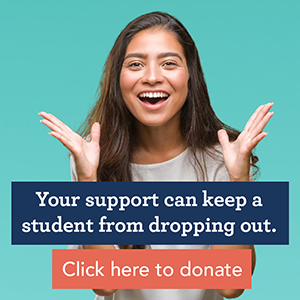
How Students Can Graduate With Less Student Loan Debt
Filed In
- Advocating for Students
Topics
- College Debt
- Reducing Debt
By Claire Berge Schmidt
Updated May 2024
Texans have an average of more than $26,000 in student loan debt. Residents of New Hampshire, almost $40,000. People in nearly half the states in the union face an average loan debt of more than $30,000. Wherever you may live, student loan debt is a problem that hits home. Even with student debt repayment reforms, there are still 45.3 million Americans facing loan debt, creating a nearly $2 trillion (and growing) crisis.
For young people, adults returning to college, first-generation students and many others, the consequences of mounting student loans can be a shock. It’s telling when former students, struggling to make ends meet after college graduation, say “I can’t help but wonder what my life would be like without student loan debt.” That’s why educating yourself, and then educating others, is one of the most valuable ways to help reduce student loan debt.
 Questions to Ask before Borrowing
Questions to Ask before Borrowing
For some students, avoiding loans may not be possible – after all, college tuition rates have increased 3.5 percent per year on average over the last decade. But if you or someone you know is considering college, here are several questions to ask that can help reduce student loans (or even avoid them altogether).
What do I actually need?
It’s important to know what you, your family or the students in your community are getting into when signing onto a loan. Limiting borrowing to the smallest amount possible will make a world of a difference when it’s time to start paying loans back. Taking out an extra $5,000 in private student loans may not seem like a huge amount now, but it could become overwhelming in four years, with interest charges building while a student tries to find a job.
Is there a more affordable school?
It’s also important to discuss college options in addition to loan options. With more than 6,000 post-secondary institutions in the U.S., there’s a lot of variance in factors like size, location and cost — and the most expensive schools might not be the best fit. For many students, staying close to home and attending a two-year college for general-education credits can be a money-saving, cost-efficient way to get started and reduce student loans. In everything, it’s important to “know before you owe.”
Have I exhausted federal aid options?
Leverage federal student aid first, including federal loans, before turning to private student loans. Federal student loans are made by the government, with terms and conditions that are set by law. They are generally cheaper and have better repayment terms and conditions than private student loans. Under special circumstances, you may also qualify for loan forgiveness in which the federal government forgives part, or all, of your federal student loans.
Is it a fixed or variable interest rate loan?
Unlike federal loans, which are subject to fixed interest rates, private loans are offered by private organizations like banks and credit unions, and may be subject to variable interest rates. Fixed interest rates are unchanged for the loan’s lifetime, while variable interest rates may change every so often. Even if the interest rate on a variable-rate loan is initially lower than the interest rate on a fixed-rate loan, the variable-rate loan may ultimately be more expensive if the interest rate increases significantly over the life of the loan.
Are you eligible for student loan forgiveness?
There are numerous different student loan forgiveness programs available for people who work in education, public service and health care, among other industries. Over the last few years, the Biden administration has relaxed some requirements and expanded these programs, so be sure and consult the Student Aid website to see if you qualify.
These are a few of the vital questions to ask in order to better understand what you, your child or the students you advise are getting into. Learning what to ask, and finding the answers that fit, is a crucial component of reducing student loan debt.
What Can Student Advocates Do?
Student loans aren’t the only way to pay for college. For low-income students, Pell Grants are still an extremely valuable resource, and many institutions are willing to provide generous grants and work-study funds to help build a more economically diverse student body. All students should complete their Free Application for Federal Student Aid (FAFSA) as early as possible to have the best chance at these grants, and community advocates, advisers and coaches should seek opportunities to help with this process.
In addition, as students search for ways to afford college, advocating for community scholarships plays a vital role in reducing a student’s loan burden. Supporting the creation and continuation of scholarships is both financially and psychologically fulfilling. Not only will it ensure that a student will receive aid that he or she can count on, but it bolsters the student’s confidence to pursue their studies.
To sweeten the deal, renewable scholarships can incentivize a student to stay in school: These impactful awards are given to the student each year, provided they meet program requirements such as a certain grade point average. Scholarships, grants and other awards that don’t require repayment are the mark of a community’s support for an education that will reap benefits for generations to come.
Finally, it’s important to recognize student loan debt affects students at all ages and stages in life—whether attending community college for the first time or enrolling in a Ph.D. program. That means that supporting all levels of postsecondary education is crucial. A recent New America report explains that about 40 percent of recent federal loan disbursements are for graduate — not undergraduate — student debt. From trade school to law school, and from high school seniors to returning adult students, scholarship awards for every stripe of student contribute to reducing student loan debt.
We all want what’s best for our nation and neighborhood. Education, advocacy and support of scholarships can all help face up to the student loan crisis. Reducing student loan debt enables students to pursue their educational and career dreams—and that will make our communities and our country stronger.
 hbspt.cta.load(241375, '7c009b0f-bcd6-47c3-8693-749e076f7dee', {});
hbspt.cta.load(241375, '7c009b0f-bcd6-47c3-8693-749e076f7dee', {});
Related Articles
Browse All
Our team is here to help you achieve your goals and build your custom scholarship program.

